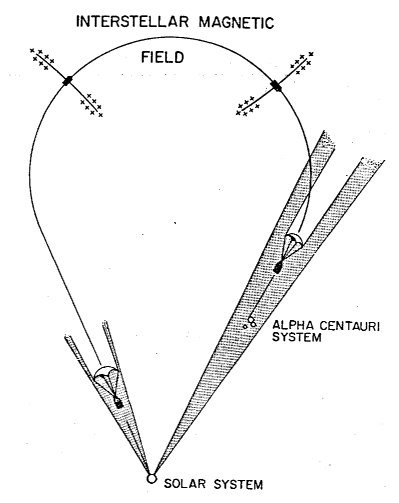
Xenology: An Introduction to the Scientific Study of Extraterrestrial Life, Intelligence, and Civilization
First Edition
© 1975-1979, 2008 Robert A. Freitas Jr. All Rights Reserved.
Robert A. Freitas Jr., Xenology: An Introduction to the Scientific Study of Extraterrestrial Life, Intelligence, and Civilization, First Edition, Xenology Research Institute, Sacramento, CA, 1979; http://www.xenology.info/Xeno.htm
17.3.4 Beamed Power Laser Propulsion
We have seen that it may be best to use an external source of energy to achieve near-optic speeds. The interstellar ramjet discussed above is a good example of this technique. Another possibility is the Laser Pushed Vehicle, or LPV.122,2767
The LPV obtains its energy and momentum from a solar-system-based laser network which pushes the ship by photon reflection from an onboard mirror. Calculations indicate that a power of roughly 1014 watts delivered to a 100-ton starship should be sufficient to impart a one-gee acceleration to the craft. Focusing would be of critical importance, and it may turn out that only x-rays will have a small enough wavelength/diameter ratio to forestall gross energy wastage. Upon arrival at a destination, LPV deceleration is effected in reverse fashion with the active assistance of the receiving civilization.22
What if there is no receiving civilization? Is the Laser Pushed Vehicle strictly limited to one-way flyby missions of exploration? The answer, apparently, is no.
According to Philip Norem, a space-based laser system could be used to accelerate a starprobe up to relativistic velocities. After a while, the craft extends long wires and charges them up to high voltage. These would interact with the Galactic magnetic field, swinging the LPV around in a slow, giant arc (Figure 17.4). The course is chosen to aim back through the target star system, but on a general heading towards Earth. The wires are discharged and reeled in; the orbital laser network is turned on again, this time functioning to decelerate the starcraft.2756
Figure 17.4 Beamed Power Propulsion Laser-Pushed Vehicle718
Very large space-based laser arrays would be required to carry out such a mission, perhaps as big as 250 kilometers in diameter. These should be parked in close solar orbit, drawing their power directly from the high solar flux available there. For maximum efficiency, the LPV’s mirrored "sail" should be of a size comparable to that of the laser array -- perhaps 250 km wide, weighing thousands of tons even if it is very thin. Surprisingly, the laser array energy flux need not be very high to push a vehicle to relativistic speeds. Typically the beam should be no more powerful than ordinary sunlight.
A proposed hybrid system combines the best qualities of the interstellar ramjet and the laser pushed vehicle and avoids many of their disadvantages. Called the Laser Powered Ramjet, or LPR, the starcraft obtains its power from a space-based laser network and its reaction mass from the interstellar medium using an electromagnetic ramscoop. The propulsion system is greatly simplified because the LPR does not require an onboard hydrogen-burning fusion reactor motor -- since all power is furnished by laser beam. Calculations suggests that the LPR may be superior to the LPV under virtually all conditions. It should also outperform the Bussard ramjet at speeds below 14%c during the acceleration phase and at all speeds during the deceleration phase of the mission.2733
Whitmire and Jackson propose two additional alternative propulsion systems that appear promising. The first of these is the Laser Powered Rocket, which differs from the LPR because it carries along its own reaction mass onboard instead of gathering it from the interstellar medium. Extraordinary energy efficiency may be possible because the exhaust velocity is controllable.2733 The second possibility may be called the Particle Powered Ramjet, which obtains its reaction mass, its fuel, or both from space-based particle accelerators:
After acceleration, the particles could be neutralized by the addition of electrons or positrons to avoid coulomb spreading of the beam. The neutral particle current required would be relatively modest -- for antimatter, about 105 amps to produce 1014 watts on board at low velocities. The problem seems to be collimation since there is no particle analogue to the laser.2733
Last updated on 6 December 2008